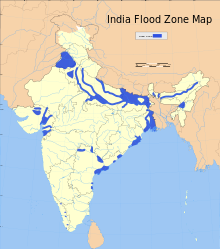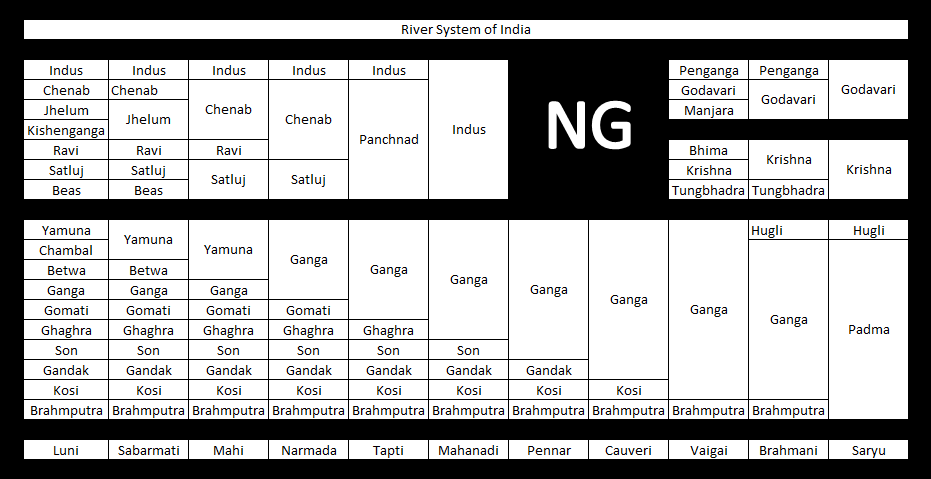भारत क मुख्य नदी सभ


भारत क मुख्य नदी सभ के भारतीय लोगन के जिनगी मे एगो महत्वपूर्ण भूमिका बा. एकनि से पानी, सस्ता परिवहन, बिजली आ बहुते लोगन के रोजगार मीलेला. This easily explains why nearly all the major cities of भारत are located by the banks of rivers. The rivers also have an important role in Hindu Dharma and are considered holy by all Hindus in the country.[1]
Seven major rivers along with their numerous tributaries make up the river system of India. The largest basin system of the rivers pour their waters into the Bay of Bengal; however, some of the rivers whose courses take them through the western part of the country and towards the east of the state of Himachal Pradesh empty into the Arabian Sea. Parts of Ladakh, northern parts of the Aravalli range and the arid parts of the Thar Desert have inland drainage.
All major rivers of India originate from one of the three main watersheds:
- The Himalaya and the Karakoram ranges
- Vindhya and Satpura ranges and Chotanagpur plateau in central India
- Sahyadri or Western Ghats in western India
The Indo-Gangetic Plains
[संपादन करीं]Known as Ganga-Satluj Ka Maidaan (गँगा सतलज का मैदान), this area is drained by 16 major rivers. The major Himalayan Rivers are the Indus, Ganges, and Brahmaputra. These rivers are long,and are joined by many large and important tributaries. Himalayan rivers have long courses from their source to sea.(in India Arabian sea and Bay of Bengal)
Ganges River System
[संपादन करीं]The major rivers in this system are (in order of merging, from west to east)
- Ganga - Starting from Gangotri Glacier, Uttarakhand
- Chambal - Not Himalayan river, covers MP and UP before merging into Yamuna
- Betwa - Not Himalayan river, covers Madhya Pradesh and Uttar Pradesh before merging into Yamuna
- Yamuna - Yamuna runs its most of the course parallel to Ganga before contributing its water to Ganga at Allahabad
- Gomti - Starts near the junction of three borders viz. Nepal, Uttarakhand and UP
- Ghaghra - Starts in Nepal near Uttarakhand
- Son - Not Himalayan river, covers MP, UP, Jharkhand and बिहार. Largest of Ganga's southern tributaries
- Gandak - Starts from Nepal
- Kosi - Starts from Bihar, near Indo-Nepal border
- Brahmputra - Merges with Ganga to form the grand river (but short in length) - Padma in Bangladesh. By now, flow velocity of both rivers slow down to considerable extent as they are in plains now.
Before entering Bangladesh, Ganga leaves a distributary Hugli, which provides water for irrigation in West Bengal
Indus River System
[संपादन करीं]The 'Indus River originates in the northern slopes of the Kailash range near Lake Mansarovar in Tibet. Although most of the river's course runs through neighbouring Pakistan, as per as regulation of Indus water treaty of 1960, India can only use only 20 percent of the water in this river. A portion of it does run through Indian territory, as do parts of the courses of its five major tributaries, listed below. These tributaries are the source of the name of the Punjab of South Asia; the name is derived from the punch ("five") and aab ("water"), hence the combination of the words (Punjab) means "land with the water of five rivers". The Indus is 3200 km long.
The major rivers in Indus river system are (in order of their length):
- Indus - 3200 km
- Chenab - 960 km
- Jhelum - 813 km
- Ravi - 720 km
- Sutlej - 529 km
- Beas - 460 km
- Shyok
- Zanskar
Annual flows and other data
[संपादन करीं]India experiences an average precipitation of 1,170 mm per year, or about 4,000 km3 of rains annually.[2] Some 80% of its area experiences rains of 750 mm or more a year. However, this rain is not uniform in time or geography. Most of the rains occur during its monsoon seasons (June to September), with the northeast and north receiving far more rains than India's west and south. Other than rains, the melting of snow year round over the Himalayas feeds the northern rivers to varying degrees. The southern rivers, however experience more flow variability over the year. For the Himalayan basin, this leads to flooding in some months and water scarcity in others. Despite extensive river system, safe clean drinking water as well as irrigation water supplies for sustainable agriculture are in shortage across India, in part because it has, as yet, harnessed a small fraction of its available and recoverable surface water resource.[3] India harnessed 761 km3 (20%) of its water resources in 2010, part of which came from unsustainable use of groundwater. Of the water it withdrew from its rivers and groundwater wells, India dedicated about 688 km3 to irrigation, 56 km3 to municipal and drinking water applications and 17 km3 to industry.[2]
According to 2011 report of the Food and Agriculture Organization of the United Nations, India's basin wise distribution of catchment area and utilizable surface water resources is presented in the following table:[2]
| Basin number | River basin unit | Region | Draining into | Catchment area (% of river irrigated India) |
Average runoff (km3) |
Additional available surface water (km3) |
|---|---|---|---|---|---|---|
| 1.1 | Ganges (GBM) | North | 26.5 | 525.02 | 250 | |
| 1.2 | Brahmaputra (GBM) | Northeast | 6 | 537.24 | 24 | |
| 1.3 | Meghna/Barak (GBM) | East | 1.5 | 48.36 | ||
| 2 | Other Northeast rivers | Northeast | 1.1 | 31 | ||
| 3 | Subernarekha | East-southeast | Bay of Bengal | 0.9 | 12.37 | |
| 4 | Brahmani-Baitarani | East-southeast | Bay of Bengal | 1.6 | 28.48 | 6.8 |
| 5 | Mahanadi | Central-east | Bay of Bengal | 4.4 | 66.88 | 18.3 |
| 6 | Godavari | Central | Bay of Bengal | 9.7 | 110.54 | 50 |
| 7 | Krishna | Central | Bay of Bengal | 8 | 78.12 | 76.3 |
| 8 | Pennar | Southeast | Bay of Bengal | 1.7 | 6.32 | 58 |
| 9 | Kaveri | South | Bay of Bengal | 2.5 | 21.36 | 6.9 |
| 10 | East flowing rivers between Mahanadi and Pennar | Central-east | Bay of Bengal | 2.7 | 22.52 | 19 |
| 11 | East flowing rivers between Kanyakumari and Pennar | Southeast | Bay of Bengal | 3.1 | 16.46 | 13.1 |
| 12 | West flowing rivers between Tadri and Kanyakumari | Southwest | Arabian Sea | 1.7 | 113.53 | 16.7 |
| 13 | West flowing rivers between Tapi and Tadri | Southwest | Arabian Sea | 1.7 | 87.41 | 24.3 |
| 14 | Tapi | Central-west | Arabian Sea | 2 | 14.88 | 11.9 |
| 15 | Narmada | Central-west | Arabian Sea | 3.1 | 45.64 | 14.5 |
| 16 | Mahi | Northwest | Arabian Sea | 1.1 | 11.02 | 34.5 |
| 17 | Sabarmati | Northwest | Arabian Sea | 0.7 | 3.81 | 3.1 |
| 18 | West flowing rivers between Kutsh and Saurashtra | Northwest | Arabian Sea | 10 | 15.1 | 1.9 |
| 19 | Rajasthan inland basin | Northwest | 0 | Negligible | 15 | |
| 20 | Indus tributaries | Northwest | 10 | 73.31 | 46 | |
| Total (per International Treaty) |
100 | 1869.37 | 690.3 |
The Peninsular River System
[संपादन करीं]The main water divide in peninsular rivers is formed by the Western Ghats, which run from north to south close to the western coast. Most of the major rivers of the peninsula such as the Mahanadi, the Godavari, the Krishna and the Kaveri flow eastwards and drain into the Bay of Bengal. These rivers make delta at their mouth. The Narmada and Tapti are the only long rivers, which flow west and make estuaries.

इहो देखल जाय
[संपादन करीं]- Indian Rivers Inter-link
- Amazon river basin
- Rhine river basin
- Danube river basin
- Nile river basin
- Yangtze river basin
References
[संपादन करीं]- ↑ Sunil Vaidyanathan, Rivers of India, ISBN 978-8189738884, 2012
- ↑ 2.0 2.1 2.2 FAO, India - Rivers Catchment, Aquastat, United Nations (2011)
- ↑ K.L. Rao, India's Water Wealth, ISBN 978-8125007043, 1979
